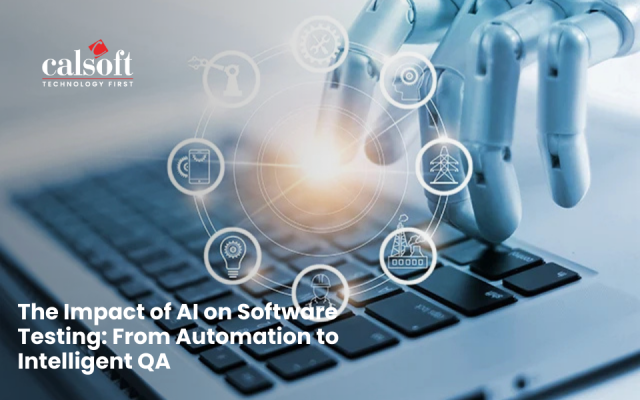At Calsoft, we’re always looking for what’s next in tech. We’ve implemented a transformative HR ops tool: an HR-Copilot powered by Langchain. This Copilot is designed to assist employees in navigating company policies, accelerate the onboarding process, and provide immediate, conversationally accessible support.
How was this achieved? This blog post will take a deeper look at the technical foundations and the role Langchain played in the development of this HR copilot.
Introduction to Langchain
Langchain is a versatile Python library designed to facilitate the construction of applications harnessing Large Language Models (LLMs) for various tasks. It offers a suite of tools that make it simpler to interface with LLMs and to weave them into the flow of existing applications, data sources, and workflows. Langchain’s capabilities include conversational memory, retrieval mechanisms, and easy integration with document databases, which are pivotal for building a system like the Calsoft HR Copilot.
Constructing the HR Copilot
The Calsoft HR copilot is strategically constructed to provide automated, AI-driven conversational assistance to employees. Here’s a step-by-step breakdown of the development process, highlighting the contributions of Langchain at each stage:
Step 1: Preparing the Dataset
At the heart of the AI Copilot is data – primarily documents like company policies, HR manuals, and FAQs in CSV, PDF, and TXT formats. The success of an AI-driven tool lies in its ability to understand and retrieve information from these documents. Langchain’s document loaders (CSVLoader, PyPDFLoader, TextLoader) and RecursiveCharacterTextSplitter are employed to process and split these documents into manageable chunks that can be later used by the LLM for question-answering tasks.
Step 2: Embedding Documents with OpenAI
Before the chatbot can answer any questions, it needs to know where to look for answers. It requires embedding the documents to convert textual information into numerical vectors that are easily searchable. The OpenAIEmbeddings module of Langchain facilitates this by leveraging OpenAI’s powerful embedding models.
Step 3: Storing and Retrieving Embeddings
After generating embeddings with OpenAIEmbeddings, they are stored in a searchable index using Langchain’s FAISS vector store, making the retrieval of relevant document segments efficient. Thus, when an employee asks a question, the HR Copilot can quickly find the most relevant part of the documents to craft an answer.
Step 4: Engaging with ChatOpenAI and Conversational Retrieval
With embedded documents ready, Langchain’s ChatOpenAI and ConversationalRetrievalChain take center stage. ChatOpenAI is designed to handle the conversational aspect of the model (in this case, either GPT-3.5 or GPT-4), allowing the chatbot to maintain a natural dialogue with users. Simultaneously, ConversationalRetrievalChain manages the retrieval of information from the stored document embeddings, fusing the outputs of LLMs and documents seamlessly for coherent, context-aware responses.
Step 5: Creating a Custom Chatbot Class
A custom Chatbot class accesses Langchain’s functions, providing methods to initialize the chat with greetings and pre-loaded context from the documents. This class uses templates from PromptTemplate to instruct the LLM on handling queries, ensuring that responses are restricted to the information from the provided documents.
Step 6: Token Management and Usage Economy
Langchain also allows monitoring token usage via get_openai_callback, ensuring that the AI’s operations remain within the budget and efficiency thresholds set by Calsoft. This is crucial for keeping the service cost-effective while upholding high standards of response quality.
How It Works:
📂 Document Processing:
HR-Copilot can handle various file types, including CSV, PDF, and TXT.
Using Langchain’s document loaders (CSVLoader, PyPDFLoader, TextLoader), we efficiently process and extract text from these files.
The RecursiveCharacterTextSplitter is employed to split the text into manageable chunks.
🧠 Embeddings and Vector Store:
To quickly retrieve of relevant information, we generate embeddings for the extracted text using OpenAI’s OpenAIEmbeddings.
Langchain’s FAISS vector store is used to store and efficiently search through these embeddings.
💬 Chatbot Interaction:
HR-Copilot engages employees in natural conversations using Langchain’s ConversationalRetrievalChain.
The ChatOpenAI model powers the chatbot’s responses, ensuring accurate and contextually relevant answers.
Langchain’s PromptTemplate allows for customizable prompts, guiding the chatbot’s behaviour.
🎨 User Interface:
The chatbot interface is built using Streamlit, a Python library for creating interactive web apps.
Employees can easily interact with HR-Copilot, ask questions, and receive instant responses.
The chat history is maintained using Streamlit’s session state, allowing for seamless conversation flow.
Benefits:
⏰ Time Savings:
HR Copilot provides instant answers to common HR questions, reducing the time spent searching for information.
New employees can quickly get up to speed, minimizing the need for extensive training sessions.
🎓 Enhanced Learning:
HR Copilot’s conversational interface makes learning about company policies more engaging and interactive.
Employees can ask follow-up questions and receive clarification, ensuring a deeper understanding of the material.
🧩 Scalability:
As Calsoft grows, HR Copilot can easily scale to handle an increasing number of employees and documents.
Langchain’s modular architecture allows for easy integration of new data sources and models.
In a Nutshell
By utilizing Langchain’s comprehensive set of tools, Calsoft has effectively built an HR copilot that can assist employees in real time, making the onboarding process faster and more interactive. The blend of conversational memory, document retrieval, efficient embedding techniques, and customizable prompt templates provided by Langchain were key to the system’s success. With the AI copilot now operational, employees at Calsoft can enjoy a more intuitive way of getting onboarded and staying informed about company policies.
The immediate advantages are clear: time savings reduced overwhelm for HR staff, and empowered employees with instant access to critical information. The implementation of Langchain’s functionalities into Calsoft’s HR infrastructure exemplifies the potential of leveraging AI for internal processes, showcasing a future where human resources can be managed with increased efficiency and sophistication.
Interested in building a copilot yourself? Reach out for a demo or consultation on how similar solutions can be integrated into your business operations.


